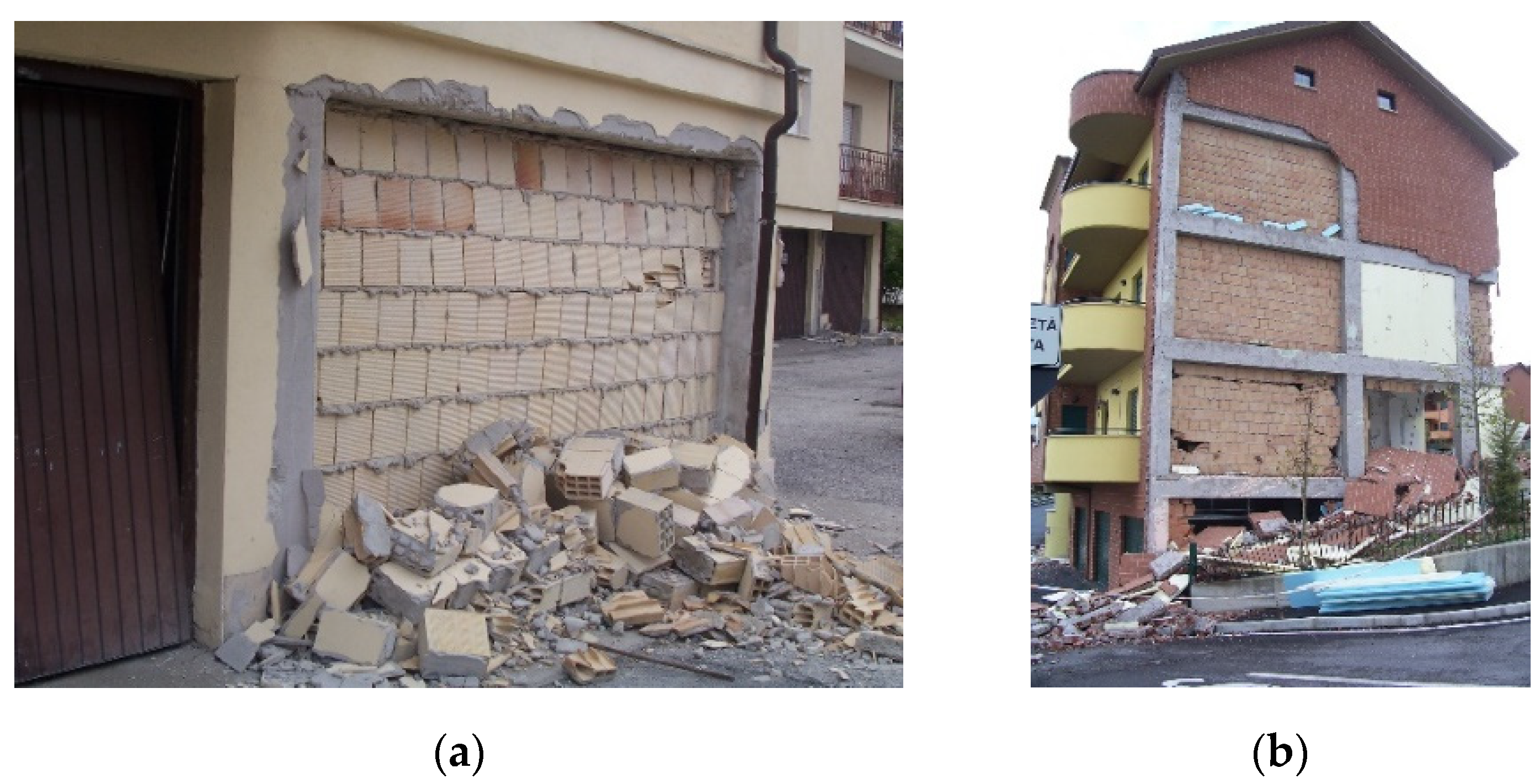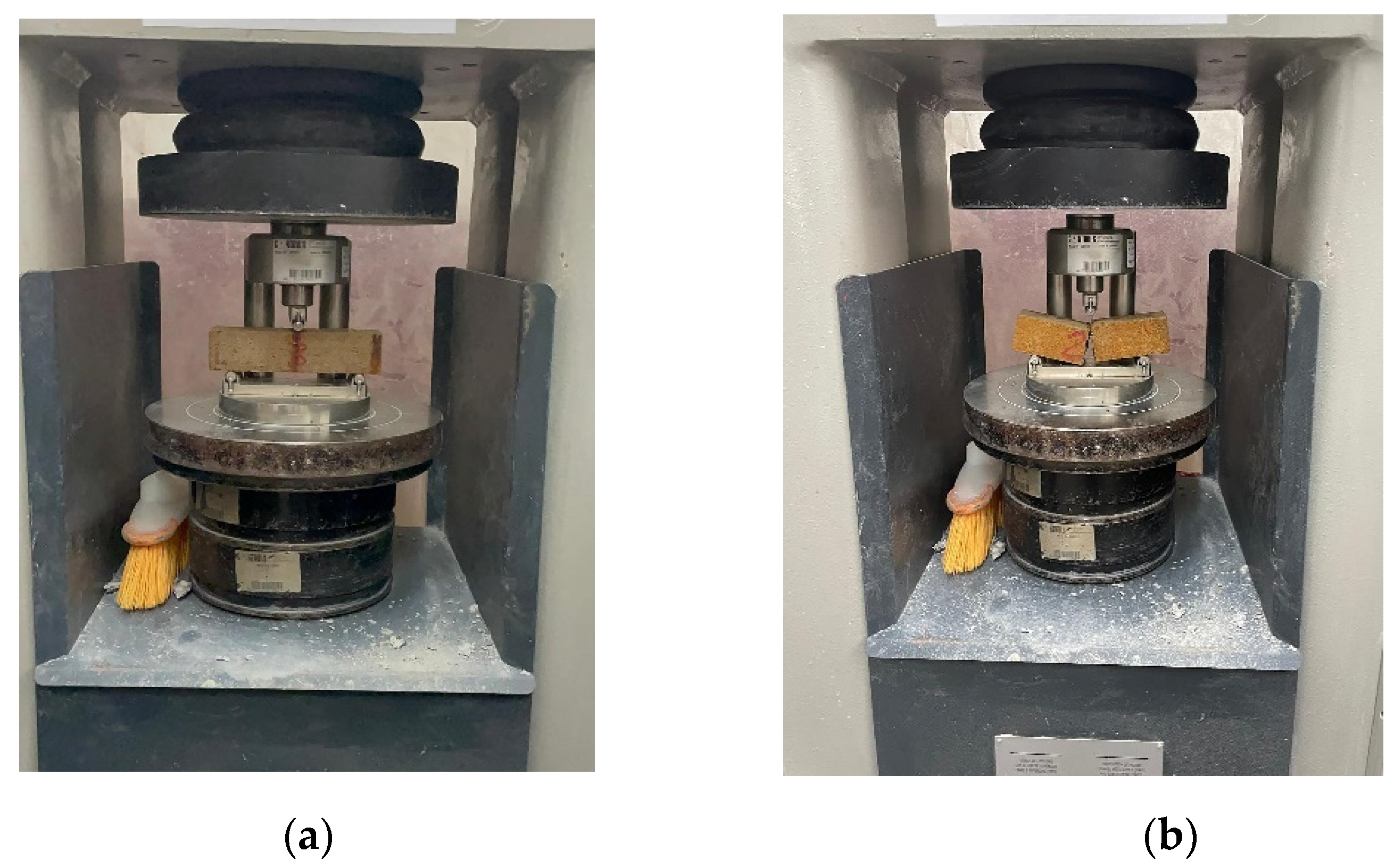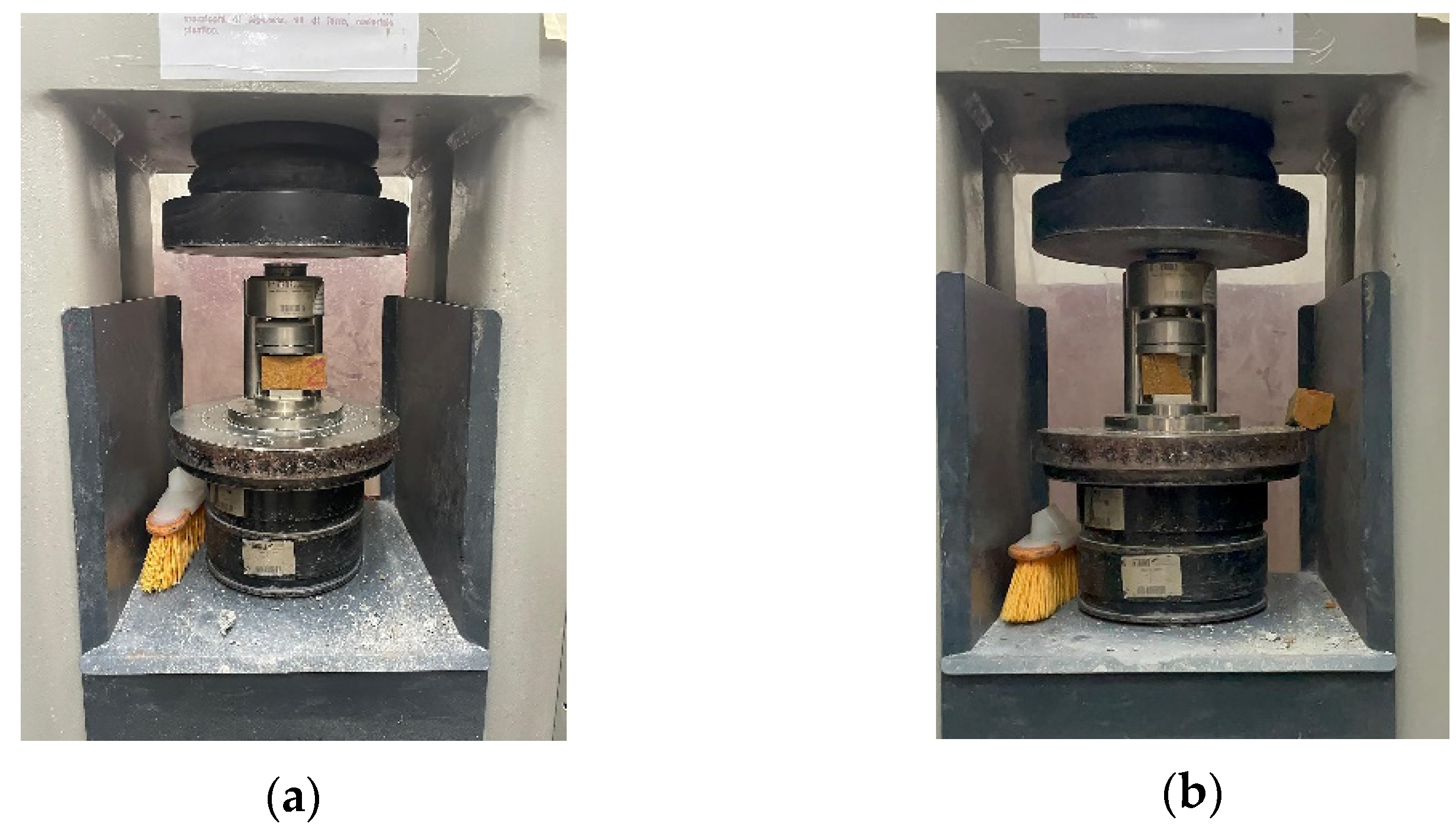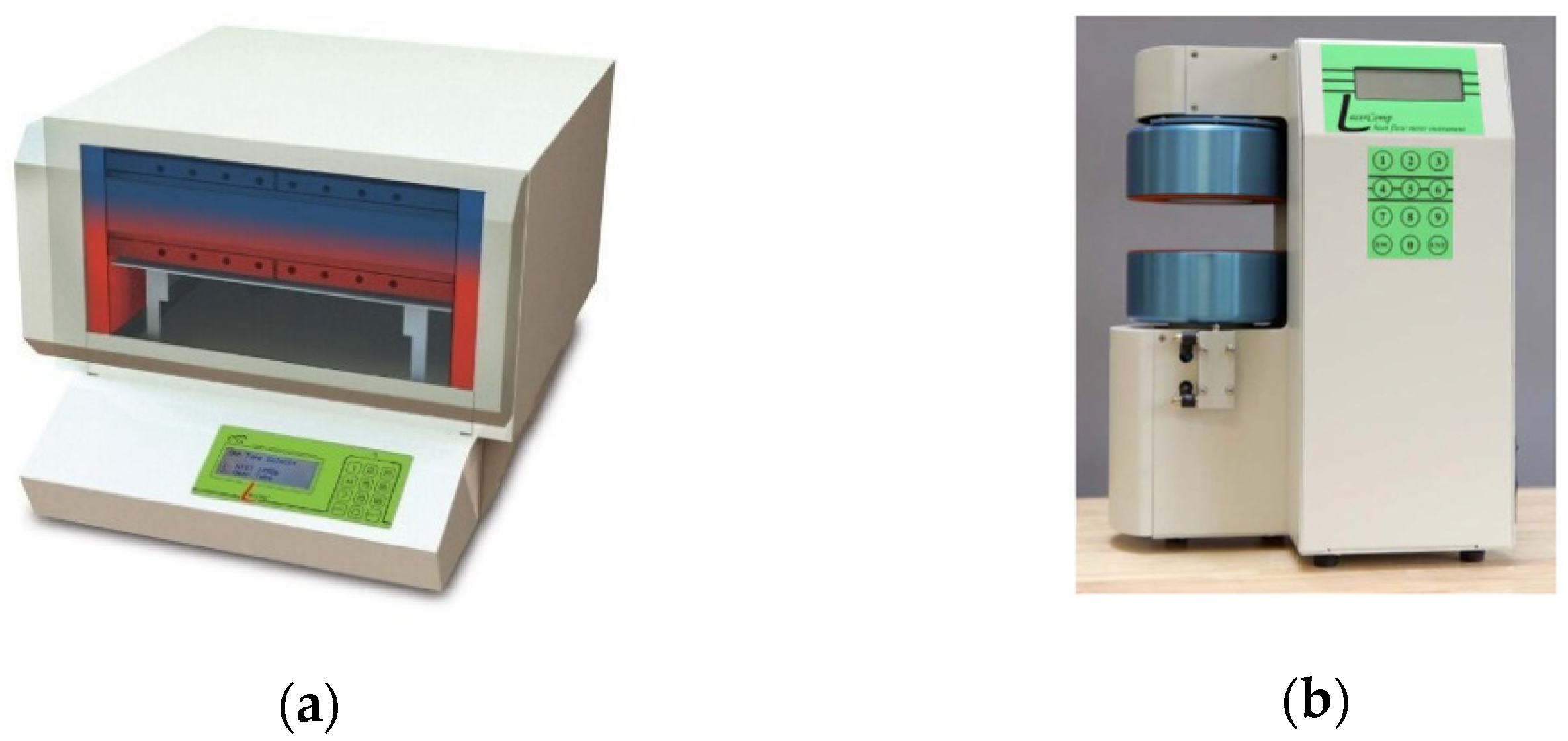Natural Lime–Cork Mortar for the Seismic and Energetic Retrofit of Infill Walls: Design, Materials, and Method
Abstract
:1. Introduction
2. Materials and Methods
2.1. Selection of Materials
2.2. Specimen Preparation
2.3. Mechanical Characterization of the Composite Matrix
- Three-point bending tests
- Uniaxial compression tests
2.3.1. Three-Point Bending Tests
- -
- l is the length of the specimen;
- -
- b and h are the respective two dimensions of the cross-section in millimeters;
- -
- Ft is the maximum force (in kN).
2.3.2. Compressive Strength Tests
2.4. Thermophysical Analysis
3. Conclusions
Author Contributions
Funding
Institutional Review Board Statement
Informed Consent Statement
Data Availability Statement
Conflicts of Interest
References
- Verderame, G.M.; Iervolino, I.; Ricci, P. Report on the Damages on Buildings Following the Seismic Event of 6th of April 2009 Time 1.32 (UTC)—L’Aquila M = 5.8, V1. 20. Available online: http://reluis.it (accessed on 21 August 2024).
- Augenti, N.; Parisi, F. Learning from construction failures due to the 2009 L’Aquila, Italy, earthquake. J. Perform. Constr. Facil. 2010, 24, 536–555. [Google Scholar] [CrossRef]
- Dolce, M.; Goretti, A. Building damage assessment after the 2009 Abruzzi earthquake. Bull. Earthq. Eng. 2015, 13, 2241–2264. [Google Scholar] [CrossRef]
- Di Ludovico, M.; Digrisolo, A.; Moroni, C.; Graziotti, F.; Manfredi, V.; Prota, A.; Dolce, M.; Manfredi, G. Remarks on damage and response of school buildings after the Central Italy earthquake sequence. Bull. Earthq. Eng. 2019, 17, 5679–5700. [Google Scholar] [CrossRef]
- Mazza, F. In-plane–out-of-plane non-linear model of masonry infills in the seismic analysis of rc-framed buildings. Earthq. Eng. Struct. Dyn. 2019, 48, 432–453. [Google Scholar] [CrossRef]
- Mazza, F.; Donnici, A. In-plane and out-of-plane seismic damage of masonry infills in existing rc structures: The case study of De Gasperi-Battaglia school in Norcia. Bull. Earthq. Eng. 2021, 19, 345–376. [Google Scholar] [CrossRef]
- Furtado, A.; Rodrigues, H.; Arede, A.; Varum, H. Experimental investigation on the possible effect of previous damage, workmanship and test setup on the out-of-plane behaviour of masonry infill walls. J. Earthq. Eng. 2022, 26, 5647–5678. [Google Scholar] [CrossRef]
- Jaysawal, R.K.; Chakraborty, S.; Elangovan, D.; Padmanaban, S. Concept of net zero energy buildings (NZEB)-A literature review. Clean. Eng. Technol. 2022, 11, 100582. [Google Scholar] [CrossRef]
- Buda, R.; Errigo, R.; Massimo, D.E.; Pucinotti, R. Seismic and energetic study on infill wall prototype: Seismic aspect. In Proceedings of the Networks, Markets & People (NMP2024), Reggio Calabria, Italy, 22–24 May 2024. [Google Scholar]
- Pohoryles, D.A.; Bournas, D.A.; Da Porto, F.; Caprino, A.; Santarsiero, G.; Triantafillou, T. Integrated seismic and energy retrofitting of existing buildings: A state-of-the-art review. J. Build. Eng. 2022, 61, 105274. [Google Scholar] [CrossRef]
- Bournas, D.A. Concurrent seismic and energy retrofitting of RC and masonry building envelopes using inorganic textile-based composites combined with insulation materials: A new concept. Compos. B Eng. 2018, 148, 166–179. [Google Scholar] [CrossRef]
- Alecci, V.; De Stefano, M.; Focacci, F.; Luciano, R.; Rovero, L.; Stipo, G. Strengthening masonry arches with lime-based mortar composite. Buildings 2017, 7, 49. [Google Scholar] [CrossRef]
- Alecci, V.; De Stefano, M.; Marra, A.M.; Pittau, F.; Pugliese, D.; Romano, R.; Stipo, G. A New Compatible and Sustainable FRLM Composite for the Seismic and Energetic Upgrade of Historic Buildings. In INTERNATIONAL SYMPOSIUM: New Metropolitan Perspectives; Springer International Publishing: Cham, Switzerland, 2022; pp. 2223–2232. [Google Scholar]
- Pugliese, D.; Alecci, V.; Romano, R.; Stipo, G.; De Stefano, M.; Nanni, A. Innovative and Sustainable Composite Material for the Seismic and Energetic Upgrade of Historic Masonry Buildings. Fibers 2023, 11, 76. [Google Scholar] [CrossRef]
- Asaithambi, B.; Ganesan, G.; Kumar, S.A. Bio-composites: Development and mechanical characterization of banana/sisal fibre reinforced poly lactic acid (PLA) hybrid composites. Fibers Polym. 2014, 15, 847–854. [Google Scholar] [CrossRef]
- Chen, X.; Gu, S.Y.; Ren, J. Research progress on processing of PLA/natural fiber composites. In Engineering Plastics Application; China Academic Journal Electronic Publishing House: Beijing, China, 2014; p. 9. [Google Scholar]
- Shah, I.; Jing, L.; Fei, Z.M.; Yuan, Y.S.; Farooq, M.U.; Kanjana, N. A review on chemical modification by using sodium hydroxide (NaOH) to investigate the mechanical properties of sisal, coir and hemp fiber reinforced concrete composites. J. Nat. Fibers 2021, 2021, 5133–5151. [Google Scholar] [CrossRef]
- Hakamy, A.; Shaikh, F.U.A.; Low, I.M. Characteristics of hemp fabric reinforced nanoclay–cement nanocomposites. Cem. Concr. Compos. 2014, 50, 27–35. [Google Scholar] [CrossRef]
- Cevallos, O.A.; Olivito, R.S. Effects of fabric parameters on the tensile behaviour of sustainablecementitious composites. Compos. Part B Eng. 2015, 69, 256–266. [Google Scholar] [CrossRef]
- Kumar, K.S.; Siva, I.; Rajini, N.; Jappes, J.W.; Amico, S.C. Layering pattern effects on vibrational behavior of coconut sheath/banana fiber hybrid composites. Mater. Des. 2016, 90, 795–803. [Google Scholar] [CrossRef]
- Shibata, S.; Cao, Y.; Fukumoto, I. Press forming of short natural fiber-reinforced biodegradable resin: Effects of fiber volume and length on flexural properties. Polym. Test. 2005, 24, 1005–1011. [Google Scholar] [CrossRef]
- Lertwattanaruk, P.; Suntijitto, A. Properties of natural fiber cement materials containing coconut coir and oil palm fibers for residential building applications. Constr. Build. Mater. 2015, 94, 664–669. [Google Scholar] [CrossRef]
- Liew, K.M.; Sojobi, A.O.; Zhang, L.W. Green concrete: Prospects and challenges. Constr. Build. Mater. 2017, 156, 1063–1095. [Google Scholar] [CrossRef]
- Izquierdo, I.S.; Izquierdo, O.S.; Ramalho, M.A.; Taliercio, A. Sisal fiber reinforced hollow concrete blocks for structural applications: Testing and modeling. Constr. Build. Mater. 2017, 151, 98–112. [Google Scholar] [CrossRef]
- Shah, I.; Li, J.; Yang, S.; Zhang, Y.; Anwar, A. Experimental investigation on the mechanical properties of natural fiber reinforced concrete. J. Renew. Mater. 2022, 10, 1307. [Google Scholar] [CrossRef]
- Brás, A.; Gonçalves, F.; Faustino, P. Cork-based mortars for thermal bridges correction in a dwelling: Thermal performance and cost evaluation. Energy Build. 2014, 72, 296–308. [Google Scholar] [CrossRef]
- UNI EN 998-1:2016; Specification for Mortar for Masonry—Part 1: Rendering and Plastering Mortar. UNI: Milan, Italy, 2016.
- EN 459-1: 2010; Building Lime. Definitions, Specifications and Conformity Criteria. CEN: Bruxelles, Belgium, 2010.
- Musolino, M.; Massimo, D.E.; Marino, C.; De Paola, P.; Errigo, R.; Malerba, A.; Del Giudice, F.P. Appraisal of energy saving in Green Buildings, supported by BIM new platforms. Valori E Valutazioni 2023, 34, 89–115. [Google Scholar] [CrossRef]
- Massimo, D.E.; Del Giudice, V.; Malerba, A.; Bernardo, C.; Musolino, M.; De Paola, P. Valuation of ecological retrofitting technology in existing buildings: A real-world case study. Sustainability 2021, 13, 7001. [Google Scholar] [CrossRef]
- Demertzi, M.; Sierra-Pérez, J.; Paulo, J.A.; Arroja, L.; Dias, A.C. Environmental performance of expanded cork slab and granules through life cycle assessment. J. Clean. Prod. 2017, 145, 294–302. [Google Scholar] [CrossRef]
- UNI EN 1015-11:2019; Methods of Test for Mortar for Masonry—Part 11: Determination of Flexural and Compressive Strength of Hardened Mortar. UNI: Milan, Italy, 2019.
- UNI EN 196-1:2007; Metodi Di Prova Dei Cementi—Parte 1: Determinazione Delle Resistenze Meccaniche. UNI: Milan, Italy, 2007.
- UNI EN 12667; Thermal Performance of Building Materials and Products—Determination of Thermal Resistance by Means of Guarded Hot Plate and Heat Flow Meter Methods—Products of High and Medium Thermal Resistance, Management. UNI: Milan, Italy, 2002.
- ASTM C518-17; Standard Test. Method for Steady-State Thermal Transmission Properties by Means of the Heat Flow Meter Apparatus. ASTM: West Conshohocken, PA, USA, 2017.
- Buda, R.; Marino, C.; Nucara, A.; Pietrafesa, M.; Pucinotti, R. Innovative and sustainable composite material for the seismic and energetic retrofit of masonry infill walls. In Proceedings of the Networks, Markets & People (NMP2024), Reggio Calabria, Italy, 22–24 May 2024. [Google Scholar]
- Grist, E.R.; Paine, K.A.; Heath, A.; Norman, J.; Pinder, H. The environmental credentials of hydraulic lime-pozzolan concretes. J. Clean. Prod. 2015, 93, 26–37. [Google Scholar] [CrossRef]







| Binder | Granulometry (mm) | Density (kg/m3) | Compressive Strength σ (N/mm2) | Thermal Conductivity λ (W/m2K) |
|---|---|---|---|---|
| Natural hydraulic Lime NHL 5 | from 0 to 4 | 1350.00 | 5.00 | 0.066 |
| Insulating | Typology | Granulometry (mm) | Density ρ (kg/m3) | Thermal Conductivity λ [W/(mxK)] |
|---|---|---|---|---|
| Cork | Granules | 1.5 | 150.00 | 0.043 |
| Matrix Name | Lime [g] | Water [g] | Cork Ratio [%] | Cork Amount [g] | Sand [g] |
|---|---|---|---|---|---|
| Matrix15 | 450.0 | 225.00 | 15 | 9.7 | 1340.30 |
| Matrix30 | 450.0 | 225.00 | 30 | 19.4 | 1330.60 |
| Specimens Matrix | Mass [g] | Lo [mm] | l [mm] | b [mm] | h [mm] | Mv [kg/m3] | Ft [N] | Rt [MPa] |
|---|---|---|---|---|---|---|---|---|
| M15-C1 | 512 | 160 | 100 | 40 | 40 | 2000 | 1650 | 3.87 |
| M15-C2 | 519 | 160 | 100 | 40 | 40 | 2027 | 1195 | 2.80 |
| M15-C3 | 510 | 160 | 100 | 40 | 40 | 1992 | 1450 | 3.40 |
| Specimens Matrix | Mass [g] | Lo [mm] | l [mm] | b [mm] | h [mm] | Mv [kg/m3] | Ft [N] | Rt [MPa] |
|---|---|---|---|---|---|---|---|---|
| M30-C1 | 503 | 160 | 100 | 40 | 40 | 1965 | 1600 | 3.75 |
| M30-C2 | 509 | 160 | 100 | 40 | 40 | 1988 | 1000 | 2.88 |
| M30-C3 | 515 | 160 | 100 | 40 | 40 | 2012 | 800 | 2.34 |
| Specimen Code | Mass [g] | Fc [N] | Rc [MPa] |
|---|---|---|---|
| M15-C11 | 254 | 3900 | 2.76 |
| M15-C12 | 258 | 4050 | 2.83 |
| M15-C21 | 258 | 3800 | 2.16 |
| M15-C22 | 261 | 3920 | 2.25 |
| M15-C31 | 253 | 3750 | 2.44 |
| M15-C32 | 257 | 3900 | 3.35 |
| Specimen Code | Mass [g] | Fc [N] | Rc [MPa] |
|---|---|---|---|
| M30-C11 | 250 | 4100 | 2.56 |
| M30-C12 | 253 | 4300 | 2.69 |
| M30-C21 | 252 | 3800 | 2.38 |
| M30-C22 | 254 | 4000 | 2.50 |
| M30-C31 | 250 | 3900 | 2.44 |
| M30-C32 | 260 | 4000 | 3.19 |
| Measure ID | tlow (°C) | tup (°C) | tavg (°C) | k W/mk |
|---|---|---|---|---|
| 1 | 0 | 20 | 10 | 0.4088 |
| 2 | 15 | 35 | 25 | 0.4060 |
| 3 | 25 | 45 | 35 | 0.4009 |
| 4 | 35 | 55 | 45 | 0.3958 |
| Average | 0.4029 | |||
| Standard Deviation | 0.0057 | |||
| Measure ID | tlow (°C) | tup (°C) | tavg (°C) | k W/mk |
|---|---|---|---|---|
| 1 | 5 | 25 | 15 | 0.3900 |
| 2 | 15 | 35 | 25 | 0.3929 |
| 3 | 25 | 45 | 35 | 0.3919 |
| Average | 0.3916 | |||
| Standard Deviation | 0.0015 | |||
| Measure ID | tlow (°C) | tup (°C) | tavg (°C) | k W/mk |
|---|---|---|---|---|
| 1 | 5 | 25 | 15 | 0.4459 |
| 2 | 15 | 35 | 25 | 0.4455 |
| 3 | 25 | 45 | 35 | 0.4455 |
| Average | 0.4456 | |||
| Standard Deviation | 0.0002 | |||
Disclaimer/Publisher’s Note: The statements, opinions and data contained in all publications are solely those of the individual author(s) and contributor(s) and not of MDPI and/or the editor(s). MDPI and/or the editor(s) disclaim responsibility for any injury to people or property resulting from any ideas, methods, instructions or products referred to in the content. |
© 2024 by the authors. Licensee MDPI, Basel, Switzerland. This article is an open access article distributed under the terms and conditions of the Creative Commons Attribution (CC BY) license (https://creativecommons.org/licenses/by/4.0/).
Share and Cite
Buda, R.; Pucinotti, R. Natural Lime–Cork Mortar for the Seismic and Energetic Retrofit of Infill Walls: Design, Materials, and Method. Appl. Sci. 2024, 14, 7503. https://doi.org/10.3390/app14177503
Buda R, Pucinotti R. Natural Lime–Cork Mortar for the Seismic and Energetic Retrofit of Infill Walls: Design, Materials, and Method. Applied Sciences. 2024; 14(17):7503. https://doi.org/10.3390/app14177503
Chicago/Turabian StyleBuda, Rocco, and Raffaele Pucinotti. 2024. "Natural Lime–Cork Mortar for the Seismic and Energetic Retrofit of Infill Walls: Design, Materials, and Method" Applied Sciences 14, no. 17: 7503. https://doi.org/10.3390/app14177503






